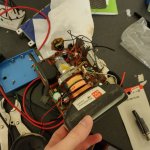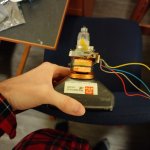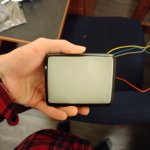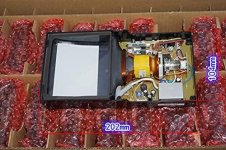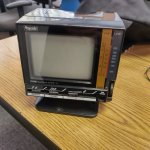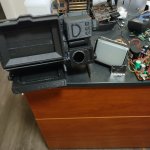CompaqSniffer
Experienced Member
I posted a thread earlier about a Sony watchman FD-10A, and got a little off topic.
Long story short, I wanted to use the FD-10A for the screen, but it had some issues and I didn't feel like buying a bunch of parts right now. I got lucky and my professor gave me an old B/W television, and it's a 4.5in screen. There are so many other CRTs I could've used, but this is the one I have and I think it'll work.
If anyone knows of someone who's attempted this before please link me videos, I could use the help. As far as I know no one has done this so I'm in murky water.
- If you have any cool CRT suggestions for this I'll still take them, here's some I know so far:
- Camera viewfinder CRTs( they're about 1in)
- Electrostatic oscilloscope tubes(specifically the 1in ones since they're really short).
- Any Sony watchman really, also any side mounted e gun CRTs.
- a Sony watch cube might work but I can't find them.
All of these tubes have something in common, and that's that they are small, but most importantly short. In order for this to work well, I don't want the CRT to be longer than 4in, with the neck board.
AN example of a unicorn CRT that would do perfectly, would meet every one of these requirements, but we don't live in a perfect world so finding a CRT like this is impossible:
- Any monochrome that's not B/W
- less than 4" long
- 3" wide diagonally
- has a tiny controller board like a viewfinder CRT.
Good luck Internet sleuths because you won't find it, instead let me show you what I have, and tell you where I'm at with this.
I'm currently trying to replicate a Pip-boy 2000 mk.4, because for some reason Bethesda decided to put their best designed pip-boy in their worst designed game, Fallout 76(admittedly I have played a lot of it and I'm ashamed to admit it). Politics aside, this is my favorite model because it actually has two little vacuum tubes under the Geiger counter and the holotape reader is clearly visible on the bottom. This pip-boy is also the largest if you factor in the IRL real model. I've seen many people make pip-boys but they always use an LCD screen. I don't blame them, it's way less of a headache to do so. Here's a 3D-printed (inaccurate) model so we know what we're working with: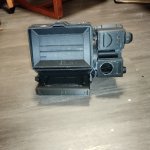
Don't let the picture fool you, this thing is massive, just the plastic alone, and this thing feels like a wrist mounted brick. Don't worry, I'm not using this exact model, this is just a reference point (modeling my own is going to be a nightmare though, the central piece took 50 hours to print).
Trust me I'm an engineer(physics major).
Anyway here's it next to the tube I'm using:
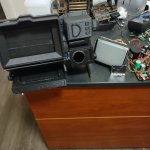
That tube is 4.5in along the diagonal for scale.
This is it in its original case:
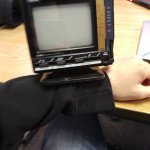
Here's how big it is in reference to my arm:
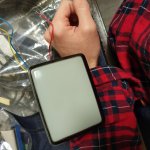
Currently I am working on composite modding this thing, I want to fully reverse engineer the controller board and slim it down. I have some perf board for this, and I have the datasheet for the video chip. I plan on fully removing the tuner, and that should slim it down a little. If anyone knows how to easily drive a B/W TV please let me know, this controller board is single sided, but it's still going to be painful to reverse engineer it without a schematic.
I can post images of both sides of the board if you want me to.
Here's how it's going with the composite mod, I was probing the board in this picture,(yes I know I'm not using a scope that can see the composite signal in all of it's glory) and was looking for a composite signal. What's on the scope in the picture is composite video from my raspberry pi.
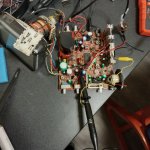
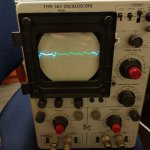
Here's the arm strap I'm using, it's two zebra wrist terminal bracelets. The blue thing is me prototyping a mount that clips onto them:

Here's the walkman clone I ordered for the "holo-tape" reader. It has a built-in radio so I'm killing two birds with one stone, knocking the radio and the tape drive off of the list:
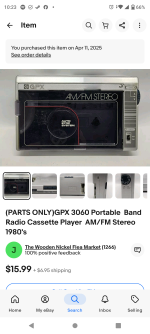
It says parts only, but that's because the battery bank is slightly corroded, the description says it still plays.
Am I forgetting something? Idk I've been typing this for about an hour on my phone, I'm just going to post it, I'm hungry.
Long story short, I wanted to use the FD-10A for the screen, but it had some issues and I didn't feel like buying a bunch of parts right now. I got lucky and my professor gave me an old B/W television, and it's a 4.5in screen. There are so many other CRTs I could've used, but this is the one I have and I think it'll work.
If anyone knows of someone who's attempted this before please link me videos, I could use the help. As far as I know no one has done this so I'm in murky water.
- If you have any cool CRT suggestions for this I'll still take them, here's some I know so far:
- Camera viewfinder CRTs( they're about 1in)
- Electrostatic oscilloscope tubes(specifically the 1in ones since they're really short).
- Any Sony watchman really, also any side mounted e gun CRTs.
- a Sony watch cube might work but I can't find them.
All of these tubes have something in common, and that's that they are small, but most importantly short. In order for this to work well, I don't want the CRT to be longer than 4in, with the neck board.
AN example of a unicorn CRT that would do perfectly, would meet every one of these requirements, but we don't live in a perfect world so finding a CRT like this is impossible:
- Any monochrome that's not B/W
- less than 4" long
- 3" wide diagonally
- has a tiny controller board like a viewfinder CRT.
Good luck Internet sleuths because you won't find it, instead let me show you what I have, and tell you where I'm at with this.
I'm currently trying to replicate a Pip-boy 2000 mk.4, because for some reason Bethesda decided to put their best designed pip-boy in their worst designed game, Fallout 76(admittedly I have played a lot of it and I'm ashamed to admit it). Politics aside, this is my favorite model because it actually has two little vacuum tubes under the Geiger counter and the holotape reader is clearly visible on the bottom. This pip-boy is also the largest if you factor in the IRL real model. I've seen many people make pip-boys but they always use an LCD screen. I don't blame them, it's way less of a headache to do so. Here's a 3D-printed (inaccurate) model so we know what we're working with:

Don't let the picture fool you, this thing is massive, just the plastic alone, and this thing feels like a wrist mounted brick. Don't worry, I'm not using this exact model, this is just a reference point (modeling my own is going to be a nightmare though, the central piece took 50 hours to print).
Trust me I'm an engineer(physics major).
Anyway here's it next to the tube I'm using:

That tube is 4.5in along the diagonal for scale.
This is it in its original case:

Here's how big it is in reference to my arm:

Currently I am working on composite modding this thing, I want to fully reverse engineer the controller board and slim it down. I have some perf board for this, and I have the datasheet for the video chip. I plan on fully removing the tuner, and that should slim it down a little. If anyone knows how to easily drive a B/W TV please let me know, this controller board is single sided, but it's still going to be painful to reverse engineer it without a schematic.
I can post images of both sides of the board if you want me to.
Here's how it's going with the composite mod, I was probing the board in this picture,(yes I know I'm not using a scope that can see the composite signal in all of it's glory) and was looking for a composite signal. What's on the scope in the picture is composite video from my raspberry pi.


Here's the arm strap I'm using, it's two zebra wrist terminal bracelets. The blue thing is me prototyping a mount that clips onto them:

Here's the walkman clone I ordered for the "holo-tape" reader. It has a built-in radio so I'm killing two birds with one stone, knocking the radio and the tape drive off of the list:

It says parts only, but that's because the battery bank is slightly corroded, the description says it still plays.
Am I forgetting something? Idk I've been typing this for about an hour on my phone, I'm just going to post it, I'm hungry.

